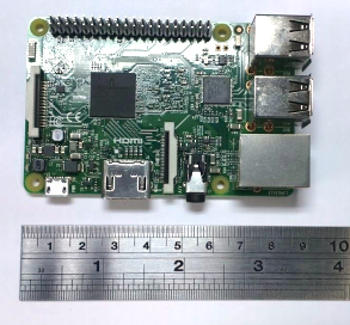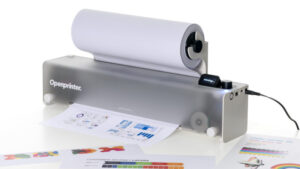The Raspberry Pi Foundation has officially announced the launch of the Raspberry Pi 3, which is the first Pi to come with built-in wireless capabilities and a 64-bit processor.
The Pi Podcast was able to get an exclusive interview with Raspberry Pi founder Eben Upton on what exactly is the Raspberry Pi 3 and how it stacks up to the rest of the Raspberry Pi lineup. Here’s the takeaway from the interview.

Photo source: FCC
Wireless and Bluetooth: The Raspberry Pi Foundation has heard the cries from the public and answered them. The Pi 3 will come with built in 802.11 wireless LAN, Bluetooth 4.1 and Bluetooth LE. One reason the Raspberry Pi Foundation had been holding off on wireless was because in the beginning it had been beyond the budget and the ability of the foundation. For the past two years, the foundation has been at the drawing board coming up with the most sound way to get wireless and bluetooth on board, and now those plans have come to fruition. Since both wireless and Bluetooth are connected to the Broadcom chip via a separate bus and not through a USB port, the Wi-Fi will be faster than using a Wi-Fi dongle.
Other changes: Now that wireless has been built into the board, the LEDs have been moved. Due to this, the foundation will be building a new official case. This new case will have a better overall look and feel than the old official case.

Cost: The Pi 3 will be priced right around $35. The foundation does understand that price is an important factor and wants to keep the price at the same or right around the current cost of the Pi 2.
Production: Production of the Pi 3 has been underway since January and the foundation has 200–300 thousand units ready to ship. They are hoping to have 100 thousand units produced on a weekly basis going forward to keep up with the demand till they are ahead of the curve.
Future of the Raspberry Pi: The foundation is looking to improve OpenGL support for the Pi 3 and is expecting the driver support to fully be there in the coming months. Going forward, expect to see the foundation shift focus towards the memory footprint and work to increase the amount of available RAM to above a gig.
I’m extremely excited about the Pi 3. I have been one of the many Raspberry Pi users wishing for Wi-Fi and not only did the Foundation deliver, they also brought Bluetooth in as well. Using the Pi 3 as a PC, you will now be able to connect to a network wirelessly and have the ability to connect peripherals with Bluetooth. When using the Pi 3 as an embedded device, you now have the option to use Bluetooth sensors with an IoT hub.
We’re currently in the midst of our 2016 Indiegogo fundraising drive. Your support is crucial. Won’t you please visit our fundraising page and make a contribution to support FOSS Force?
In addition to hosting a Raspberry Pi meetup in Washington D.C., Isaac Carter is a co-host on mintCast. He’s also a software engineer who enjoys working with Java, JavaScript, and GNU/Linux. When he’s not coding, you can find him reading on any number of subjects or on the golf course.







I think this might be the NAS that I’ve been looking for!
You have to be completely ignorant to choose Rpi over better and even cheaper alternatives in 2016.
What a lame cult this has become!
Great news!!
Go, Pi, go!!
@Markov
Please enlighten everyone with these “better and even cheaper” alternatives.
How much more would USB 3.0 cost to put on the Pi 3? IMO, that would make it a much more viable as a PC. But, I love the Pi!!
I meant Odroid C2 and even various Orange Pi’s.
Do some research man!
@Markov
> “Do some research man!”
I already have.
Odroid C2 is slightly more expensive, but comparable to a Pi3 (better in some respects worse in others). It has no mini-stereo audio out and so would be useless for my home audio solution built with Pi’s. Just try to find a stand alone set of surround speakers with an HDMI input.
Orange Pi Plus has slightly higher specs than a Pi and a slightly higher price to match.
Not everyone needs a faster CPU and the increase in price that goes with it. Several of my projects use several Pi’s working together, so even a modest increase in price is a real issue.
So I will repeat: Where are these “better and even cheaper” alternatives you mentioned?
Hint: Accusing people of cult-like behavior without knowing anything about them is rude, and makes you look like a fool.
Will the Broadcom wireless driver be opensource?
What will the Pi 3 use for the wireless antenna? Is it built into the board as well?
@Mike
Thank you for a very civil and detailed response. Markov could have simply said something like “Here are some alternatives to the Pi if anyone is interested.” There was no need for him to use the tone he did.
And I understand Markov’s feelings about all the Pi news. Some people feel like the news is saturated with certain subject matter. But if you’re tired of seeing it, ignore it. Move on to the next subject of interest.
My biggest concern is the Broadcom Wireless, I have never had good experience with them.
Even the one year-old Odroid C1/+ keeps smoking the latest Rpi and its price has been lowered to $32.
That wasn’t too hard to find, was it?
Conflating all ARM SBC’s with just one supbar brand is really irritating in 2016.
A significant advantage to using the Pi results from its popularity. Because it’s popular it gets a lot of community support which in turn leads to it being even more popular. You can’t completely overlook available operating systems and software when deciding on a single board computer. If you’re not careful, you can end up with something that gets very little support.
Of course, there are other systems that get enough support to consider, like Odroid and i.MX6 based boards. The new Pine64 is looking reasonably promising as well.
Odroid is a lot more limited than the Pi when it comes to software and available operating systems.